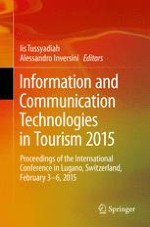2015 | OriginalPaper | Buchkapitel
Destination Brand Communication Through the Social Media: What Contents Trigger Most Reactions of Users?
verfasst von : Assumpcio Huertas, Estela Marine-Roig
Erschienen in: Information and Communication Technologies in Tourism 2015
Aktivieren Sie unsere intelligente Suche, um passende Fachinhalte oder Patente zu finden.
Wählen Sie Textabschnitte aus um mit Künstlicher Intelligenz passenden Patente zu finden. powered by
Markieren Sie Textabschnitte, um KI-gestützt weitere passende Inhalte zu finden. powered by
